Staffing and HR Trends for Small Businesses in 2022

Staffing and HR Trends for Small Businesses in 2022
Most small businesses are planning to hire several new employees in 2022. While challenges stand in the way of HR teams and ideal candidates and workplace culture, small businesses are ready to push past problems to grow their teams.
Record-high numbers of American workers quit their jobs in 2021. A total of 38 million employees decided to leave their positions in 2021, at near-record rates for seven months of that year.
Many dubbed this trend “The Great Resignation” as the trend impacted more and more industries throughout the year.
After employees resigned en masse, companies began struggling to fill vacant positions. Plenty of jobs were left sitting with no applicants at all, creating a labor shortage that’s still affecting hiring practices.
Employees quitting jobs cite toxic work cultures, a lack of work-life balance, unrealistic expectations, and feeling like they were being taken advantage of by employers.
The Great Resignation will continue to affect staffing and HR into 2022, as an estimated 70 million employees reenter the workforce — this time with more leverage than before.
The Manifest surveyed 1,003 small business owners and managers to learn about how The Great Resignation and labor shortage is affecting hiring and HR in 2022.
Our Findings
- Over half of small businesses (55%) are planning to hire in 2022, some in an attempt to fill roles from the wave of resignations experienced in 2021
- Customer service (37%), sales (32%), marketing (27%), production (27%), and information technology (26%) are the most common types of roles being filled in 2022, indicating that small businesses are searching out client-facing talent.
- About one in five small businesses hiring in 2022 (19%) will open roles for cross-functional roles that span multiple departments, revealing that employees are expected to wear multiple hats.
- In 2022, 21% of small businesses plan on hiring 20 or more employees, marking a significant need for incoming talent.
- Small businesses use social media (60%), in-house HR resources (41%), outsourced recruiting firms (36%), and HR software platforms (30%) to source and recruit candidates, highlighting the power of tech in small business staffing.
- Most small businesses intend to hire full-time employees (63%), but companies also plan on filling positions for part-time employees (28%), unpaid interns (10%), and paid interns (5%). Small businesses are hiring for permanence in 2022.
- The vast majority of small businesses (83%) admitted to facing at least one HR and staffing challenge in 2022 so far, most notably surrounding recruiting and sourcing candidates.
- Two-thirds of small businesses (67%) that are satisfied with their 2021 attrition rates think remote work positively affected their work culture, indicating that remote work offerings may be beneficial to work culture.
In search of HR assistance for your small business? Connect with a top HR company today on The Manifest.
Jump to: 10 HR Terms to Know in 2022
Most Small Businesses are Hiring in 2022
The majority of small businesses intend to hire at least one employee in 2022.
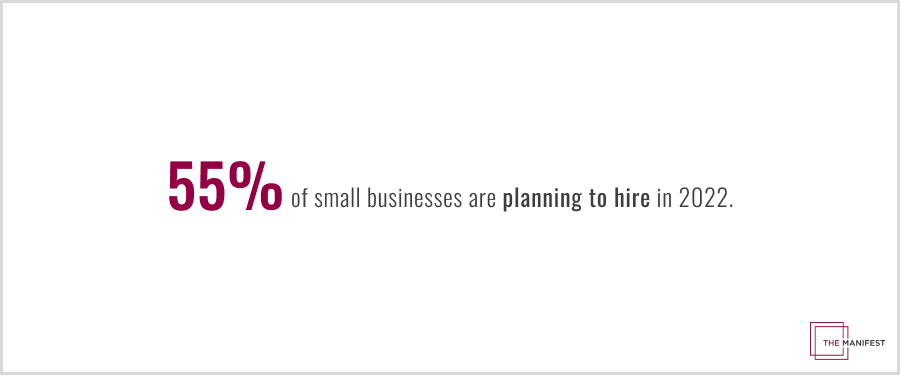
Plenty of workers are resigning and switching jobs in 2022, and small businesses are growing at the same time. Following hiring freezes and uncertainty during the height of COVID-19, small businesses are now on a more comfortable footing to make hires.
For instance, Shawn Plummer is the owner CEO of The Annuity Expert, a retirement planning and assistance firm. Plummer plans on hiring more employees this year in order to comfortably meet customer demand.
“We are looking to grow in 2022. In general, we want to have all the headcount resources we need to meet increased demand for our services and serve customers better,” Plummer said.
As pandemic-related restrictions lift and new cases drop, small businesses are looking to grow. Part of getting back on track for growth requires hiring and retaining staff. This year, companies will need to prioritize finding and keeping top talent in order to achieve growth.
Small Businesses are Recruiting for Customer-Facing Roles
Most small businesses are hiring, but what types of positions are they searching to fill?
Most available roles were customer-facing, meaning that employees interact directly with clients as part of their day-to-day responsibilities. In particular, small businesses were looking to hire customer service workers (37%) and sales employees (32%).
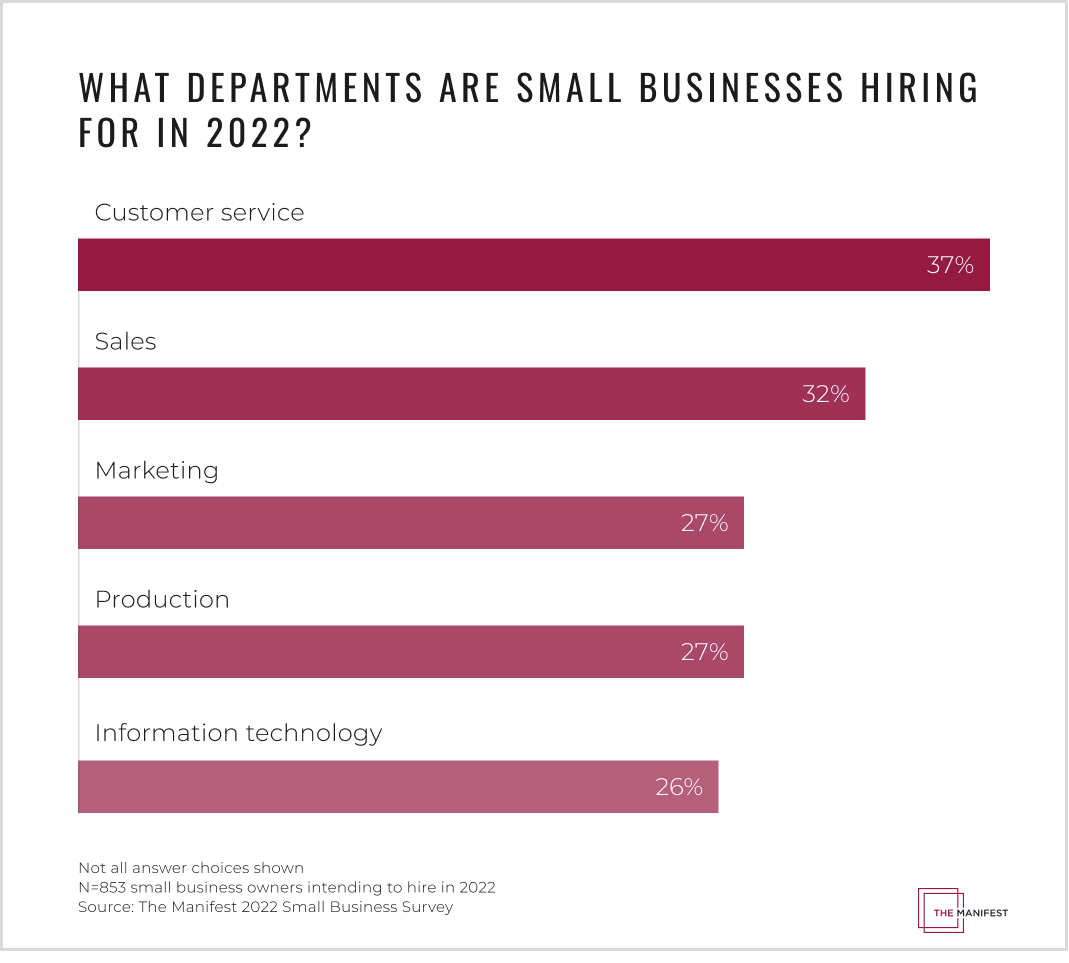
Other popular types of open positions included marketing roles (27%), production jobs (27%), and information technology opportunities (26%).
Here are some general responsibilities of each type of in-demand role:
- Customer service: plan and take customer calls, facilitate strong relationships with consumers with answers to customer questions and solutions to problems, basic data entry and troubleshooting capabilities
- Sales: generate leads through sales pitches, answer prospective customer questions about company or product, negotiate client contracts, sales reporting, perform against sales goals
- Marketing: coordinate across teams to execute promotional campaigns, conduct competitor analysis to shape campaign content, examine campaign success and report metrics back to the client
- Production: assemble and ready products for distribution, product QA testing, monitor and maintain inventory
- Information technology: maintain the functionality of company computer network and infrastructure, troubleshoot technical issues, handle cybersecurity protocol, update software
Jerry Han, chief marketing officer at survey solutions company PrizeRebel, notes that customer-facing employees are essential to expanding businesses, particularly digital-first companies that lack brick-and-mortar customer service systems.
“Client-facing roles are much more personal. There's a lot of money in personalization, and people are looking for more than faceless organizations now,” Han said.
“Client-facing roles are much more personal. There's a lot of money in personalization, and people are looking for more than faceless organizations now.”
Han also feels that companies may just now be rebuilding their customer service staff after cutting down in this area during pandemic uncertainties.
“A lot of client-facing positions were eliminated during the pandemic. It was easier to keep the core business than it was to cultivate a strong client-facing business, especially when everything was remote,” Han said.
Now, companies that decided to forego investing in client-facing relationships during the height of COVID-19 are looking for new hires — particularly in customer service and sales.
Not only are there plenty of customer-facing jobs to fill, but reports also show that the most common industries affected by the Great Resignation were positions with significant customer-facing responsibilities:
- Education
- Retail
- Health care
- Hospitality
Small businesses, especially those looking to fill customer service and sales positions, should keep in mind that the current hiring landscape favors employees. Companies should seek to meet candidate expectations when attempting to fill these positions quickly to compete in these challenging markets.
Small Businesses are Searching for Cross-Functional Teammates
Sometimes, small businesses require a new hire to assume responsibilities that span several teams.
About one-fifth (19%) of small businesses plan to fill cross-functional roles in 2022.
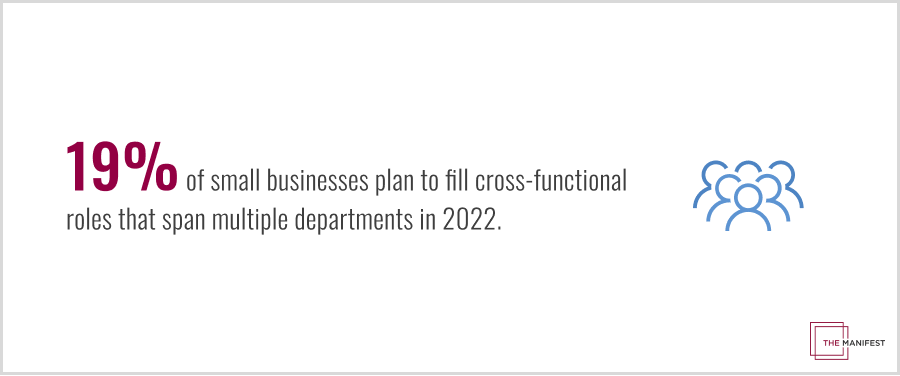
While small businesses may hire a new employee to serve a specific department, the requirements of their day-to-day work may be cross-functional.
Some small businesses may not have the resources to hire a new worker for every area of need, so they’re expecting candidates to prioritize adaptability.
However, research shows that employees don’t always appreciate wearing multiple hats. ZenBusiness found that people in younger generations feel that it’s unfair to expect employees to do tasks outside of their core role.
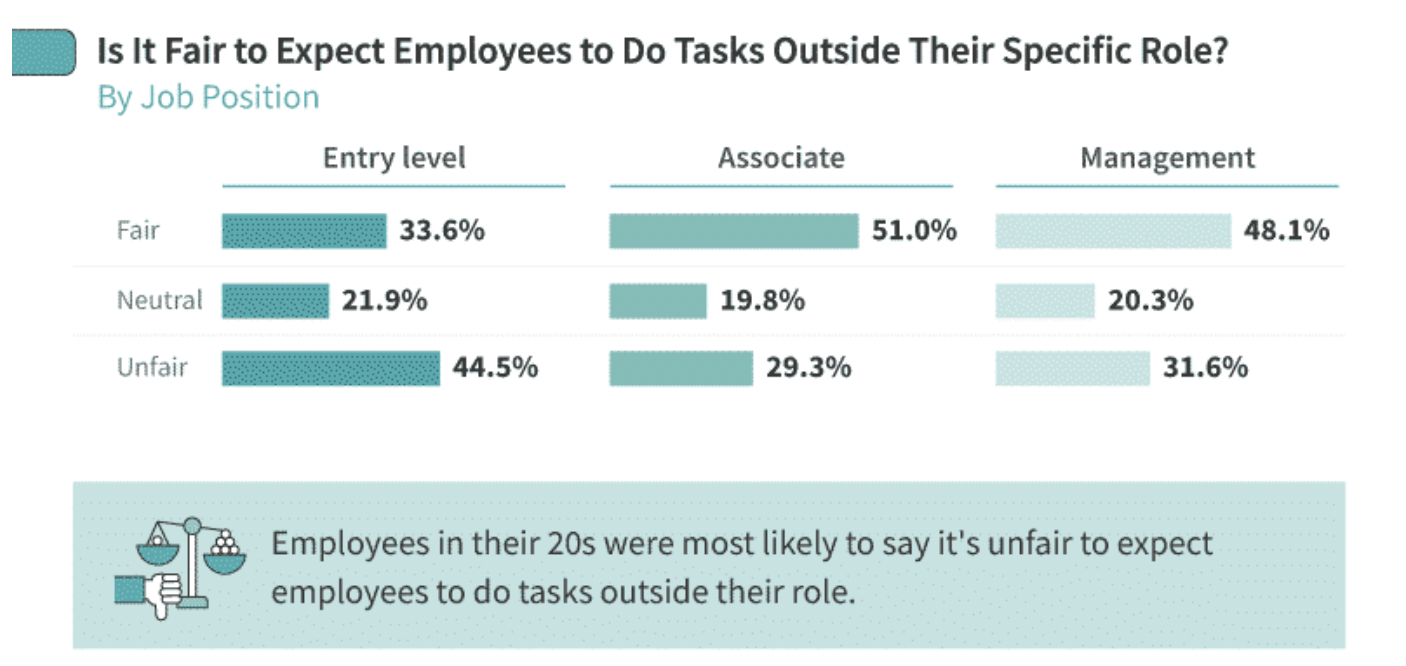
Source: ZenBusiness
Gen Z and young Millennials are generally against this practice and believe that it’s particularly unfair to ask entry-level employees to pick up extra tasks that fall outside their typical responsibilities.
Almost two in every three Gen Z employees intends to leave their job in 2022. Given their distaste for tasks outside of their core role, cross-functional positions may not appeal to them in the hunt for a new position.
Small businesses value cross-functional workers. However, they should tread carefully when it comes to asking for tasks outside of the job description if they want to appeal to young candidates in their career reshuffle.
Small Businesses are Filling Numerous Positions in 2022
Many small businesses plan to hire several employees in 2022.
More than one-fifth of small businesses (21%) are hiring 20 or more new employees this year.
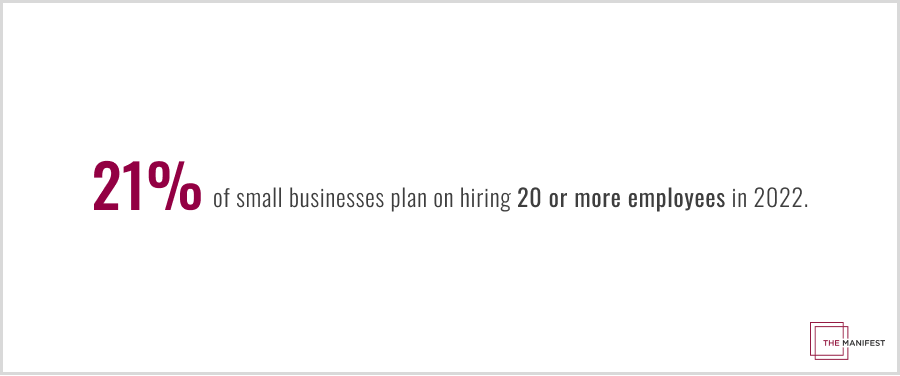
Small businesses are growing while also dealing with The Great Reshuffle of employees. This means that more positions are open at these companies than ever.
Chris Gadek, vice president of growth at out-of-home adverting solutions company AdQuick, notes that it’s been difficult to hold onto talent in the past year and that small businesses now lack a permanent set of workers.
“The Great Resignation makes it challenging for many small businesses to retain staff,” Gadek said. “And with the gig economy, every month can seem like a revolving door of employees coming and employees going.”
“The Great Resignation makes it challenging for many small businesses to retain staff. And with the gig economy, every month can seem like a revolving door of employees coming and employees going.”
The Great Resignation triggered huge growth in the gig economy. After employees left their 9-to-5s, many decided to offer services of their own. This may be why freelancers and contracted workers seem omnipresent in the hiring landscape.
In this context, it’s not surprising that small businesses are looking to bulk up with the help of permanent employees in 2022.
Small Businesses Plan to Onboard Full-Time Staff, Part-Time Employees, and Interns
Small businesses mostly intend to hire full-time staff members in 2022, but there are also expected part-time and internship openings.
Almost two-thirds of planned open roles (63%) at small businesses in 2022 will be full-time opportunities.
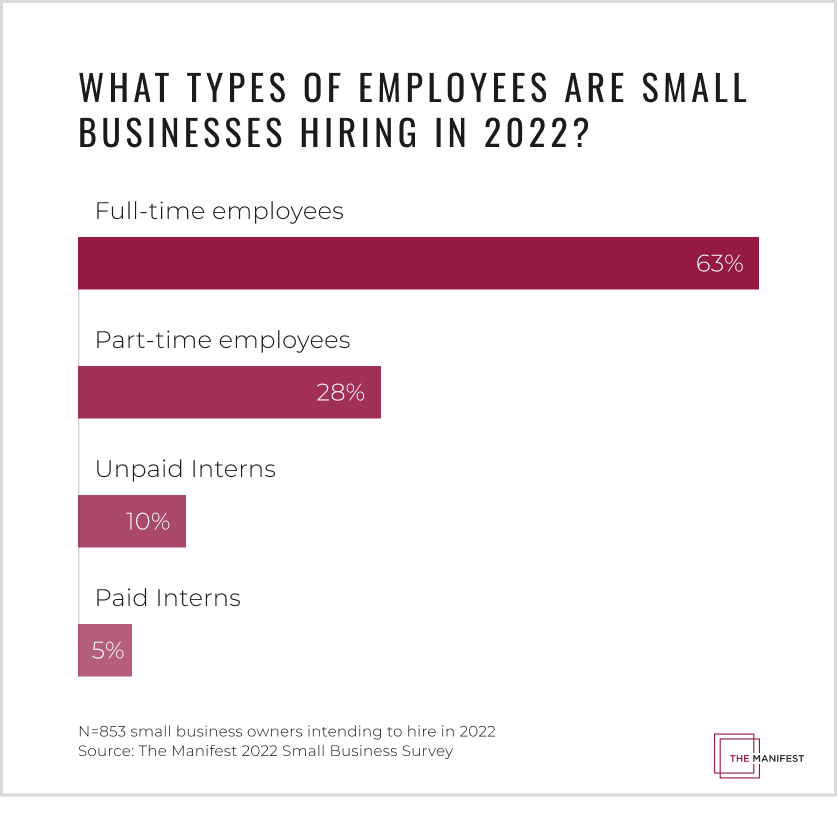
In addition to full-time roles, small businesses also plan to hire part-time employees (28%), unpaid interns (10%), and paid interns (5%).
After a couple of tumultuous years, small businesses are looking to re-establish a sense of permanence. With many hoping to continue growing, businesses are looking for permanent, full-time employees.
Small businesses may also prefer workers that actively connect with the company mission. Gadek feels that full-time employees are more likely to commit themselves to excellence than temporary hires.
“Building a solid team is a lengthy process. While hiring remote freelancers is cost-effective, they may not be as invested in working for you as much as full-time in-house employees,” Gadek said.
"While hiring remote freelancers is cost-effective, they may not be as invested in working for you as much as full-time in-house employees.”
Few Small Businesses Hiring Interns in 2022
A total of 15% of small businesses plan on hiring an intern in 2022, which isn’t very many considering the number of college students with internship experience.
Why aren’t more small businesses hiring interns?
Interns do require internal support and resources that may cause companies to hesitate to hire them, but there are plenty of benefits to having interns both before and after the internship passes.
Reports have found that internship opportunities have been slower to return after the height of the pandemic when compared to full- or part-time job openings. Especially for small businesses, having interns takes investment and resources that may not be available coming out of a pandemic.
However, some small business owners argue for the importance of interns. In addition to assisting with business tasks, interns are particularly valuable when they become full-time workers after the internship ends.
Clair Jones, CEO and creative director of LoudBird Marketing, believes that interns offer unique value to small businesses. Jones recommends that companies make the most of their experiences with interns and treat them as prospective employees.
“The beauty of internships is that they're like a trial hire. You have time to see if the person is a good fit—if they fit into the culture of your business, have a willingness to learn and are excited to contribute, and if they can truly hack it in tough situations,” Jones said. “Because a job interview, in my experience, is honestly just not that revealing.”
“The beauty of internships is that they're like a trial hire. You have time to see if the person is a good fit—if they fit into the culture of your business, have a willingness to learn and are excited to contribute, and if they can truly hack it in tough situations.”
Small businesses doubting their ability to dedicate time to hiring may benefit from working with interns, getting them acclimated to the company, and hiring them at the end of their internship.
Small Businesses Lean on Social Media for Staffing
Small businesses use a host of tools and technologies to source and recruit job candidates, but they rely on social media primarily.
Most commonly, small businesses (60%) rely on social media to facilitate the hiring process. LinkedIn, for example, allows companies to post and contact prospective employees with ease.
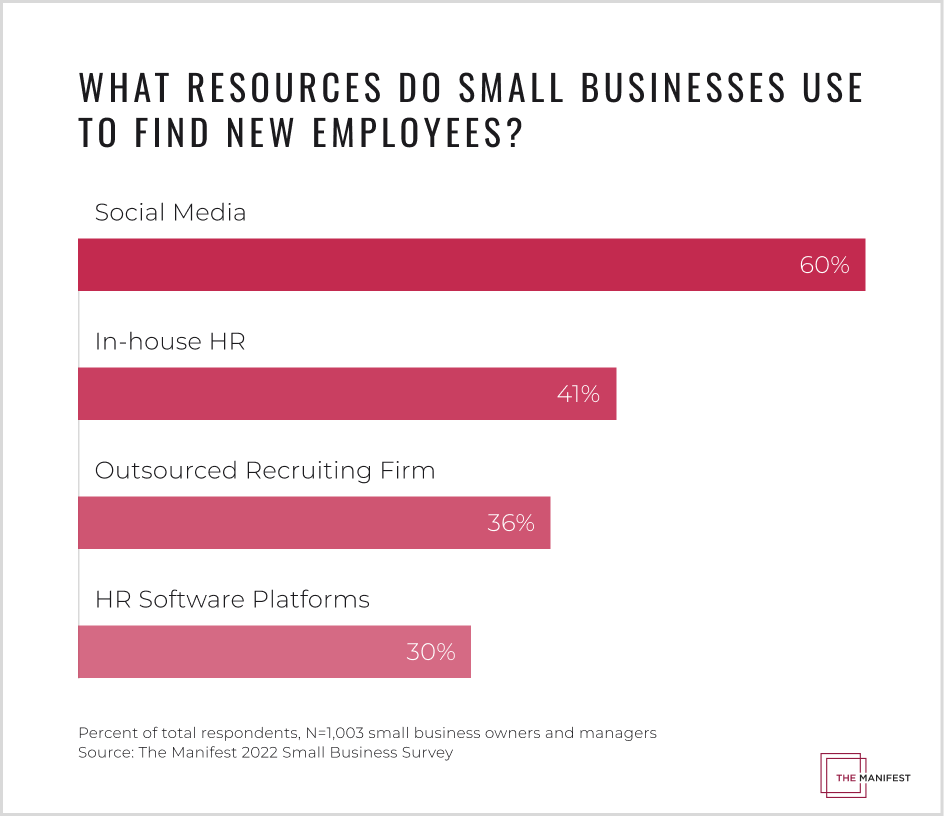
Additionally, companies regularly turn to in-house HR teams (41%), outsourced recruiting firms (36%), and HR software (30%) to make hires effectively and efficiently.
4 Different Hiring Scenarios
Here’s a peek into how each of top small business hiring approaches might work within a small business:
- Social Media: Molly runs a small business and needs to hire a sales teammate. She doesn’t have an HR team to hunt for candidates for her and will have to handle some of the hiring process herself. Molly needs to focus on running her business, so she shares a job description on LinkedIn and opts to promote the post for better circulation. Within a few days, Molly sees that several candidates have submitted resumes through the platform. She’s then able to sift through them and contact those she’d like to interview.
- In-house HR resources: Rob and Tina make up the HR department at a small business and are both involved in recruiting. When an entry-level sales position opens up at the company, they remind the team of their employee referral program that awards both the candidate and referral writer $500 upon the candidate’s hire. Rob and Tina value this program because it produces high-quality candidates and lets them focus on other aspects of their roles.
- Outsourced Recruiting Firm: Bill is the HR manager at a small business. He’s a team of one, and the business’s recruitment efforts need more attention than he’s able to give it. Because of the need to fill open roles quickly and some extra money in the annual budget, Bill was able to contract an outsourced recruiting firm to source and screen candidates for him. With the early stages of the hiring process taken care of for him, he’s able to pass along strong candidates to interviewers quickly and easily.
- HR Software Platforms: Sarah’s small business isn’t feeling so small anymore. Thanks to an impressive year of growth, she’s ready to significantly increase her headcount. She opts to invest in an HR and recruitment platform to scale the process without having to take hiring out-of-house. Sarah’s HR department can use the platform to more efficiently track candidates as they move through recruitment stages as well as employee referrals and more. Popular recruitment platforms include Greenhouse, GoHire, and Workable.
One common thread across popular hiring methods is that they’re intended to take time and energy off the hiring team’s plate. While this allows people to focus on competing priorities, experts suggest that small businesses remember the importance of building connections with candidates.
Sandy Kaminski, VP of Client Development for HR automation company Vensure HR, finds that hiring teams need to take a hands-on approach to connecting with top talent — social media alone might not cut it.
“Talent recruitment that addresses today’s new set of priorities requires creativity,” Kaminiski said. “Getting in front of exceptional talent takes more than posting on job sites or searching a candidate’s LinkedIn profile.”
“Getting in front of exceptional talent takes more than posting on job sites or searching a candidate’s LinkedIn profile.”
Time is a small business owner’s most precious resource. However, it may be worth investing some to strengthen hiring efforts.
Top HR Challenges in 2022: Recruiting, Engagement, Retention
Regardless of what small business hiring plans look like for 2022, almost all teams –no matter the industry – are dealing with HR challenges.
Currently, 83% of small businesses are facing at least one common HR and staffing challenge.
Given the turbulent nature of the job market in 2022, it makes sense that businesses are confronting challenges. Some small business owners are faced with the added difficulty of competing for talent with their larger counterparts.
For instance, Sherry Morgan is the founder of Petsolino, a resource for pet owners aiming to be better caretakers. Morgan has noticed that hiring has become more competitive, but recommends that companies showcase the value of working for a small business during the interview process.
“One of the challenges we are facing due to the Great Resignation is that now we have more competition when it comes to hiring top talent,” Morgan said. “These competitions make hiring more difficult since there will always be bigger companies who can pay bigger salaries, and provide more benefits.”
“One of the challenges we are facing due to the Great Resignation is that now we have more competition when it comes to hiring top talent.”
How Businesses Can Appeal to Top Talent
Morgan adds that Petsolino has made the following changes to its hiring process to encourage candidates to accept job offers:
- Communicating growth potential
- Showcase how candidate contributions will add value directly to customers
- Commit to increasing salaries and benefits to both new and current employees
Other small businesses can learn from Petsolino’s efforts — determine what value working at your company provides employees and make sure candidates are aware of it throughout the interview process.
What HR Challenges Do Small Businesses Face?
We know that the vast majority of small businesses are addressing HR challenges, but in which areas are small businesses struggling?
Sourcing the right candidates (30%) is the most prevalent HR and hiring challenge among small businesses in 2022.
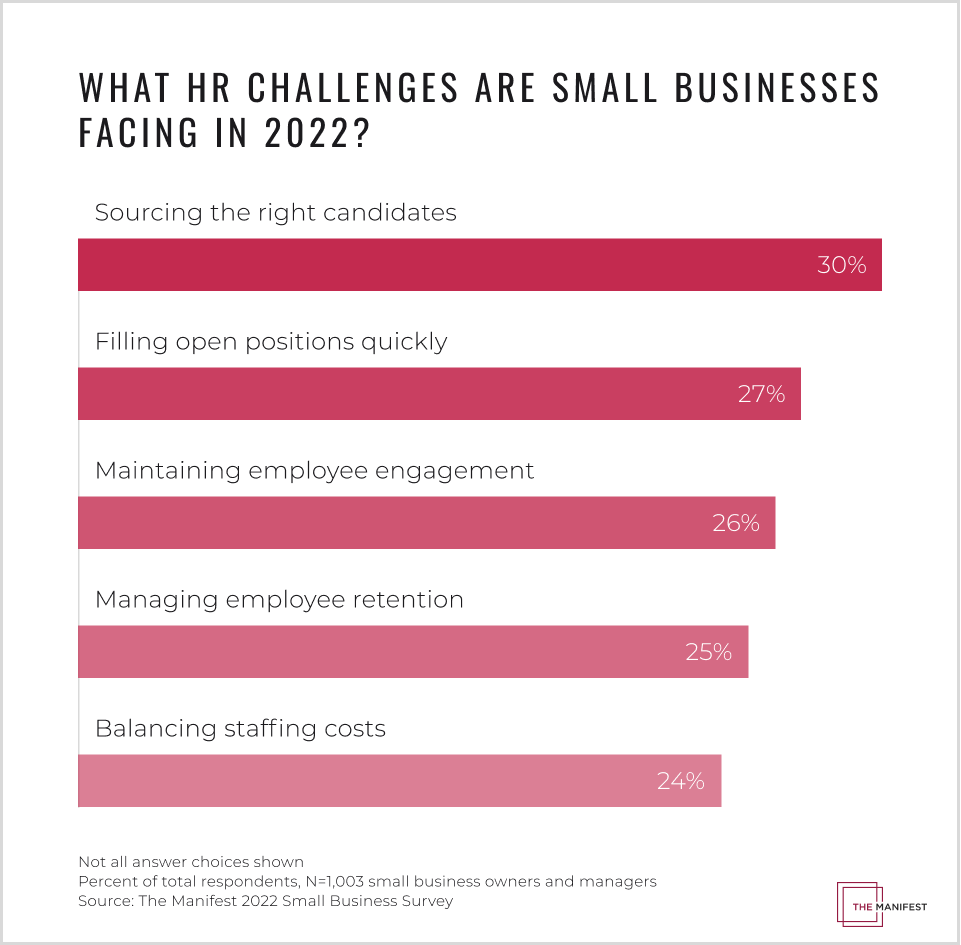
Many small businesses also admit to struggling with filling open positions quickly (27%), maintaining employee engagement (26%), managing employee retention (25%), and managing staffing costs (24%).
How to Source the Right Candidate
Kathleen Ahammed, co-founder of auto buyer USCarJunker, shares that the current competitive job market makes it difficult for small businesses to connect with the most qualified candidates before bettered resourced competitors.
“The Great Resignation spurred on by the pandemic has seriously affected many SMBs, as it has created an extremely competitive job market, in regards to what workers have come to expect in terms of salaries and benefits,” Ahammed said. “And this has meant that most small businesses have been struggling to hire top talent.”
To stand out when the competition is tough, small businesses should showcase the unique benefits of accepting an offer from them.
How to Fill Open Positions Quickly
Small businesses desire to rapidly fill vacant positions, but might not have the most efficient hiring process to accommodate that wish.
Steven Walker, CEO of online safety firm Spylix, believes that SMBs struggle with long interview processes that only hamper their agility in filling open roles.
“[Companies] have to take many rounds of interviews before hiring an employee who is best for their company,” Walker said. “This selection process takes much more time than needed.”
Experts recommend that small businesses aim to trim unnecessary steps in the interview and hiring process.
How to Maintain Employee Engagement
Employee engagement should be prioritized because ignoring low engagement could result in unexpected retention issues.
Logan Mallory, vice president of employee engagement solutions company Motivosity, says that it’s especially important to pay attention to engagement scores given the impact of the Great Resignation on small businesses.
“One of the ways the Great Resignation has affected small businesses is that they’ve had to really step up their retention and engagement strategies,” Mallory said. “Companies that focus on these efforts will have more success in keeping their existing staff as well as hiring new employees.”
Companies should remember that engagement is directly related to retention and hiring success.
How to Manage Employee Retention
Small businesses can handle any issues with retention by paying close attention to employee preferences and expectations of their employer.
Mark Webster, co-founder of marketing education company Authority Hacker said he will keep his employees remote even after the pandemic ends. Why: because that’s how they prefer to work.
“We noticed that people have been much more open to the prospect of working remotely in the past two years,” Webster said. “As a fully remote company, this was a positive change for our hiring process!”
Small business owners should adapt to meet employee needs as a means of managing retention.
How to Manage Staffing Costs
Hiring a lot of employees in one year is expensive and requires resources. Small businesses may hesitate to make the investment without the right tools and metrics to maintain a budget.
Adam Ng, the CEO and founder of Malaysian lifestyle recommendation platform Trusted, recommends that all companies track the cost-per-hire throughout the recruitment process.
“By figuring out cost-per-hire, you can maintain the track of overall hiring expenditure. With the proper evolution and analysis, you can gain significant insight into the company's profit and loss, [helping to] identify what is working and what is not,” Ng said.
“By figuring out cost-per-hire, you can maintain the track of overall hiring expenditure. With the proper evolution and analysis, you can gain significant insight into the company's profit and loss, [helping to] identify what is working and what is not."
No matter the staffing challenges small businesses face, they can move toward solutions by prioritizing empathy and the best interests of their teams.
Remote Work May Lessen Small Business Attrition Rates
While there are plenty of challenges HR teams face in 2022, remote and hybrid work options may be solutions for some small businesses
Two-thirds of small businesses (67%) are satisfied with their attrition rate and feel that remote work benefited their work culture.
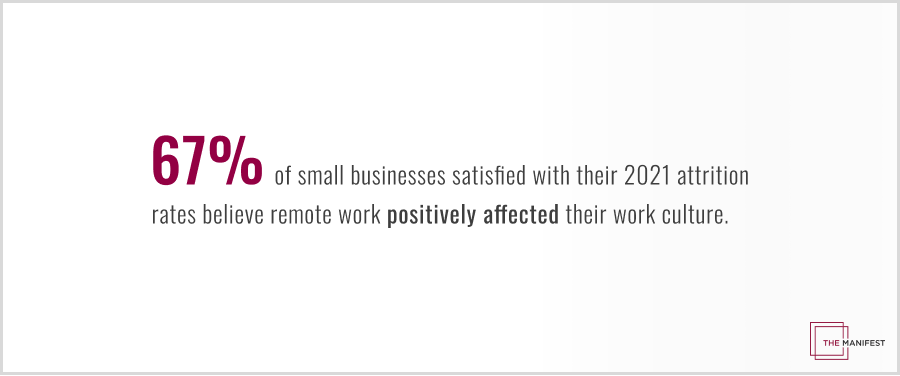
For many small businesses, remote work is the new normal. Some don't plan on requiring a return to the office, even after the pandemic subsides.
Connor Ondriska, co-founder and CEO of online Spanish learning company SpanishVIP, believes that remote work is here to stay, especially for digital-first businesses.
“Remote and hybrid environments are definitely here to stay. I think if the pandemic taught us anything, it's that we as business owners need to adapt to the needs of our consumers and our team members,” Ondriska said. “Remote work allows our employees to have a more flexible work-life balance and improve productivity.”
“Remote work allows our employees to have a more flexible work-life balance and improve productivity.”
For companies able to offer remote work, it may aid their ability to manage retention within small businesses, thus decreasing the number of vacant positions and the need to invest as heavily in recruiting.
HR Teams Must Remain Adaptable in 2022
The COVID-19 pandemic, Great Resignation, and Great Reshuffle all significantly affected the job market in a short period of time. HR teams and hiring managers must keep track of HR trends to keep up with how to best address emerging challenges in the workplace.
Especially with so many small businesses hoping to make several hires in 2022, it’s imperative that HR teams know what to expect from candidates and what candidates are now expecting from them.
Considering HR and hiring strategies for 2022? Start a conversation with a team of HR experts on The Manifest.
10 HR Terms to Know in 2022
- Applicant Tracking System (ATS): software solutions that hiring teams use to view candidates who applied for positions, monitor their progress in the interview process, and adjust their status toward hire
- Contingent Workforce Management (CWM): the process of handling one or more temporary employees from an HR perspective. This includes contact workers, gig workers, and more
- Cost-per-hire: a staffing success metric that displays how expensive it is for a company to make a hire on average
- Freelancer Management System (FMS): a software system that facilitates hiring, onboarding, assigning tasks, and paying freelance workers for companies looking for temporary or freelance workers
- Great Resignation: workplace trend that started in 2021 and entailed a high-volume wave of employees voluntarily leaving their positions at work
- Great Reshuffle: workplace trend following the Great Resignation that indicates that millions of workers are switching jobs in 2021 and 2022 to find positions they’re more passionate about
- Just-in-Time Staffing (JITS): a staffing strategy that involves companies waiting until there is a demand for a certain type of worker to make hires, especially common among those outsourcing work to freelancers or contingent workers
- Mobile Recruiting: the practice of recruitment teams using mobile technology to engage prospective candidates, especially prevalent on LinkedIn and other social platforms
- Retention rate: an HR and workplace culture metric that measures the percentage of workers that have stayed at a company for a given period of time
- Strategic Workforce Planning: the HR process of assessing and forecasting internal hiring needs and measuring them against the supply and demand of certain types of workers in the job market. This allows teams to assess gaps in their workplace and take action to hire the right people at the right times
About The Survey
The Manifest surveyed 1,003 small business owners and managers at companies in the U.S. with fewer than 500 employees in December 2021. Fifty-seven percent (57%) of respondents are male; 43% are female. Thirty-six percent (36%) are 18 to 34; 53% are 35 to 54; 11% are 55 or over. Five percent (5%) of respondents’ businesses have one employee; 28% have 2 to 10 employees; 31% have 11 to 50 employees; 24% have 51 to 250 employees; 12% have 251 to 500 employees. Respondents are from the South (42%), West (21%), Midwest (20%), and Northeast (17%).
